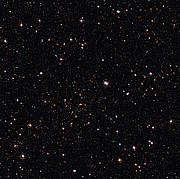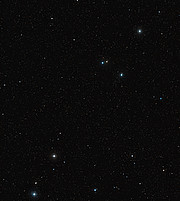Komunikat prasowy
A Cluster and a Sea of Galaxies
5 maja 2010
A new wide-field image released today by ESO displays many thousands of distant galaxies, and more particularly a large group belonging to the massive galaxy cluster known as Abell 315. As crowded as it may appear, this assembly of galaxies is only the proverbial “tip of the iceberg”, as Abell 315 — like most galaxy clusters — is dominated by dark matter. The huge mass of this cluster deflects light from background galaxies, distorting their observed shapes slightly.
When looking at the sky with the unaided eye, we mostly only see stars within our Milky Way galaxy and some of its closest neighbours. More distant galaxies are just too faint to be perceived by the human eye, but if we could see them, they would literally cover the sky. This new image released by ESO is both a wide-field and long-exposure one, and reveals thousands of galaxies crowding an area on the sky roughly as large as the full Moon.
These galaxies span a vast range of distances from us. Some are relatively close, as it is possible to distinguish their spiral arms or elliptical halos, especially in the upper part of the image. The more distant appear just like the faintest of blobs — their light has travelled through the Universe for eight billion years or more before reaching Earth.
Beginning in the centre of the image and extending below and to the left, a concentration of about a hundred yellowish galaxies identifies a massive galaxy cluster, designated with the number 315 in the catalogue compiled by the American astronomer George Abell in 1958 [1]. The cluster is located between the faint, red and blue galaxies and the Earth, about two billion light-years away from us. It lies in the constellation of Cetus (the Whale).
Galaxy clusters are some of the largest structures in the Universe held together by gravity. But there is more in these structures than the many galaxies we can see. Galaxies in these giants contribute to only ten percent of the mass, with hot gas in between galaxies accounting for another ten percent [2]. The remaining 80 percent is made of an invisible and unknown ingredient called dark matter that lies in between the galaxies.
The presence of dark matter is revealed through its gravitational effect: the enormous mass of a galaxy cluster acts on the light from galaxies behind the cluster like a cosmic magnifying glass, bending the trajectory of the light and thus making the galaxies appear slightly distorted [3]. By observing and analysing the twisted shapes of these background galaxies, astronomers can infer the total mass of the cluster responsible for the distortion, even when this mass is mostly invisible. However, this effect is usually tiny, and it is necessary to measure it over a huge number of galaxies to obtain significant results: in the case of Abell 315, the shapes of almost 10 000 faint galaxies in this image were studied in order to estimate the total mass of the cluster, which amounts to over a hundred thousand billion times the mass of our Sun [4].
To complement the enormous range of cosmic distances and sizes surveyed by this image, a handful of objects much smaller than galaxies and galaxy clusters and much closer to Earth are scattered throughout the field: besides several stars belonging to our galaxy, many asteroids are also visible as blue, green or red trails [5]. These objects belong to the main asteroid belt, located between the orbits of Mars and Jupiter, and their dimensions vary from some tens of kilometres, for the brightest ones, to just a few kilometres in the case of the faintest ones.
This image has been taken with the Wide Field Imager on the MPG/ESO 2.2-metre telescope at ESO’s La Silla Observatory in Chile. It is a composite of several exposures acquired using three different broadband filters, for a total of almost one hour in the B filter and about one and a half hours in the V and R filters. The field of view is 34 x 33 arcminutes.
Uwagi
[1] The Abell catalogue from 1958 comprised 2712 clusters of galaxies, and was integrated with an additional 1361 clusters in 1989. Abell put together this impressive collection by visual inspection of photographic plates of the sky, seeking those areas where more galaxies than average were found at approximately the same distance from us.
[2] Ten percent of a galaxy cluster’s mass consists of a very hot mixture of protons and electrons (a plasma), with temperatures as high as ten million degrees or more, which makes it visible to X-ray telescopes.
[3] Astronomers refer to these slight distortions as weak gravitational lensing, as opposed to strong gravitational lensing, characterised by more spectacular phenomena such as giant arcs, rings and multiple images.
[4] A weak lensing study of the galaxy cluster Abell 315 has been published in a paper that appeared in Astronomy & Astrophysics in 2009 (“Weak lensing observations of potentially X-ray underluminous galaxy clusters”, by J. Dietrich et al.).
[5] The blue, green or red tracks indicate that each asteroid has been detected through one of the three filters, respectively. Each track is composed of several, smaller sub-tracks, reflecting the sequence of several exposures performed in each of the filters; from the length of these sub-tracks, the distance to the asteroid can be calculated.
Więcej informacji
ESO, the European Southern Observatory, is the foremost intergovernmental astronomy organisation in Europe and the world’s most productive astronomical observatory. It is supported by 14 countries: Austria, Belgium, Czechia, Denmark, France, Finland, Germany, Italy, the Netherlands, Portugal, Spain, Sweden, Switzerland and the United Kingdom. ESO carries out an ambitious programme focused on the design, construction and operation of powerful ground-based observing facilities enabling astronomers to make important scientific discoveries. ESO also plays a leading role in promoting and organising cooperation in astronomical research. ESO operates three unique world-class observing sites in Chile: La Silla, Paranal and Chajnantor. At Paranal, ESO operates the Very Large Telescope, the world’s most advanced visible-light astronomical observatory and VISTA, the world’s largest survey telescope. ESO is the European partner of a revolutionary astronomical telescope ALMA, the largest astronomical project in existence. ESO is currently planning a 42-metre European Extremely Large optical/near-infrared Telescope, the E-ELT, which will become “the world’s biggest eye on the sky”.
Kontakt
Henri Boffin
ESO, VLT Press Officer
Garching, Germany
Tel.: +49 89 3200 6222
Tel. kom.: +49 174 515 43 24
E-mail: hboffin@eso.org
O komunikacie
| Komunikat nr: | eso1019 |
| Nazwa: | Abell 315 |
| Typ: | Early Universe : Galaxy : Grouping : Cluster |
| Facility: | MPG/ESO 2.2-metre telescope |
| Instrumenty: | WFI |
Our use of Cookies
We use cookies that are essential for accessing our websites and using our services. We also use cookies to analyse, measure and improve our websites’ performance, to enable content sharing via social media and to display media content hosted on third-party platforms.
ESO Cookies Policy
The European Organisation for Astronomical Research in the Southern Hemisphere (ESO) is the pre-eminent intergovernmental science and technology organisation in astronomy. It carries out an ambitious programme focused on the design, construction and operation of powerful ground-based observing facilities for astronomy.
This Cookies Policy is intended to provide clarity by outlining the cookies used on the ESO public websites, their functions, the options you have for controlling them, and the ways you can contact us for additional details.
What are cookies?
Cookies are small pieces of data stored on your device by websites you visit. They serve various purposes, such as remembering login credentials and preferences and enhance your browsing experience.
Categories of cookies we use
Essential cookies (always active): These cookies are strictly necessary for the proper functioning of our website. Without these cookies, the website cannot operate correctly, and certain services, such as logging in or accessing secure areas, may not be available; because they are essential for the website’s operation, they cannot be disabled.
Functional Cookies: These cookies enhance your browsing experience by enabling additional features and personalization, such as remembering your preferences and settings. While not strictly necessary for the website to function, they improve usability and convenience; these cookies are only placed if you provide your consent.
Analytics cookies: These cookies collect information about how visitors interact with our website, such as which pages are visited most often and how users navigate the site. This data helps us improve website performance, optimize content, and enhance the user experience; these cookies are only placed if you provide your consent. We use the following analytics cookies.
Matomo Cookies:
This website uses Matomo (formerly Piwik), an open source software which enables the statistical analysis of website visits. Matomo uses cookies (text files) which are saved on your computer and which allow us to analyze how you use our website. The website user information generated by the cookies will only be saved on the servers of our IT Department. We use this information to analyze www.eso.org visits and to prepare reports on website activities. These data will not be disclosed to third parties.
On behalf of ESO, Matomo will use this information for the purpose of evaluating your use of the website, compiling reports on website activity and providing other services relating to website activity and internet usage.
Matomo cookies settings:
Additional Third-party cookies on ESO websites: some of our pages display content from external providers, e.g. YouTube.
Such third-party services are outside of ESO control and may, at any time, change their terms of service, use of cookies, etc.
YouTube: Some videos on the ESO website are embedded from ESO’s official YouTube channel. We have enabled YouTube’s privacy-enhanced mode, meaning that no cookies are set unless the user actively clicks on the video to play it. Additionally, in this mode, YouTube does not store any personally identifiable cookie data for embedded video playbacks. For more details, please refer to YouTube’s embedding videos information page.
Cookies can also be classified based on the following elements.
Regarding the domain, there are:
- First-party cookies, set by the website you are currently visiting. They are stored by the same domain that you are browsing and are used to enhance your experience on that site;
- Third-party cookies, set by a domain other than the one you are currently visiting.
As for their duration, cookies can be:
- Browser-session cookies, which are deleted when the user closes the browser;
- Stored cookies, which stay on the user's device for a predetermined period of time.
How to manage cookies
Cookie settings: You can modify your cookie choices for the ESO webpages at any time by clicking on the link Cookie settings at the bottom of any page.
In your browser: If you wish to delete cookies or instruct your browser to delete or block cookies by default, please visit the help pages of your browser:
Please be aware that if you delete or decline cookies, certain functionalities of our website may be not be available and your browsing experience may be affected.
You can set most browsers to prevent any cookies being placed on your device, but you may then have to manually adjust some preferences every time you visit a site/page. And some services and functionalities may not work properly at all (e.g. profile logging-in, shop check out).
Updates to the ESO Cookies Policy
The ESO Cookies Policy may be subject to future updates, which will be made available on this page.
Additional information
For any queries related to cookies, please contact: pdprATesoDOTorg.
As ESO public webpages are managed by our Department of Communication, your questions will be dealt with the support of the said Department.



